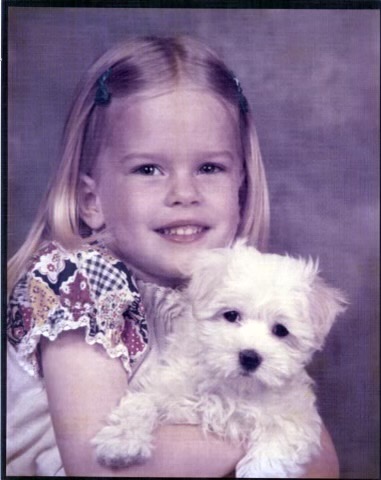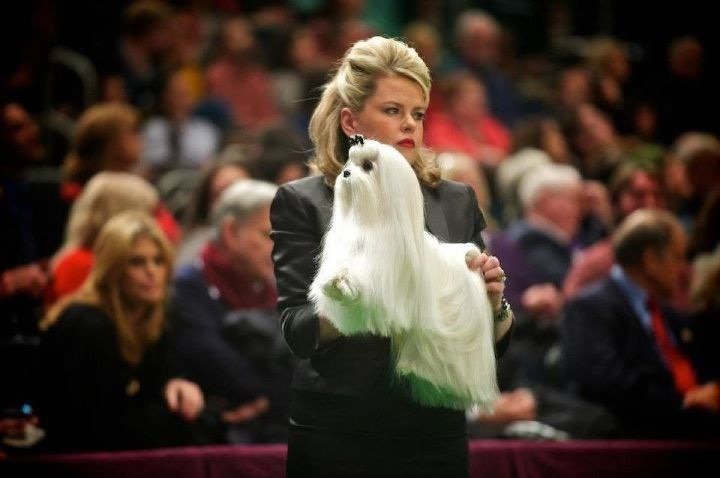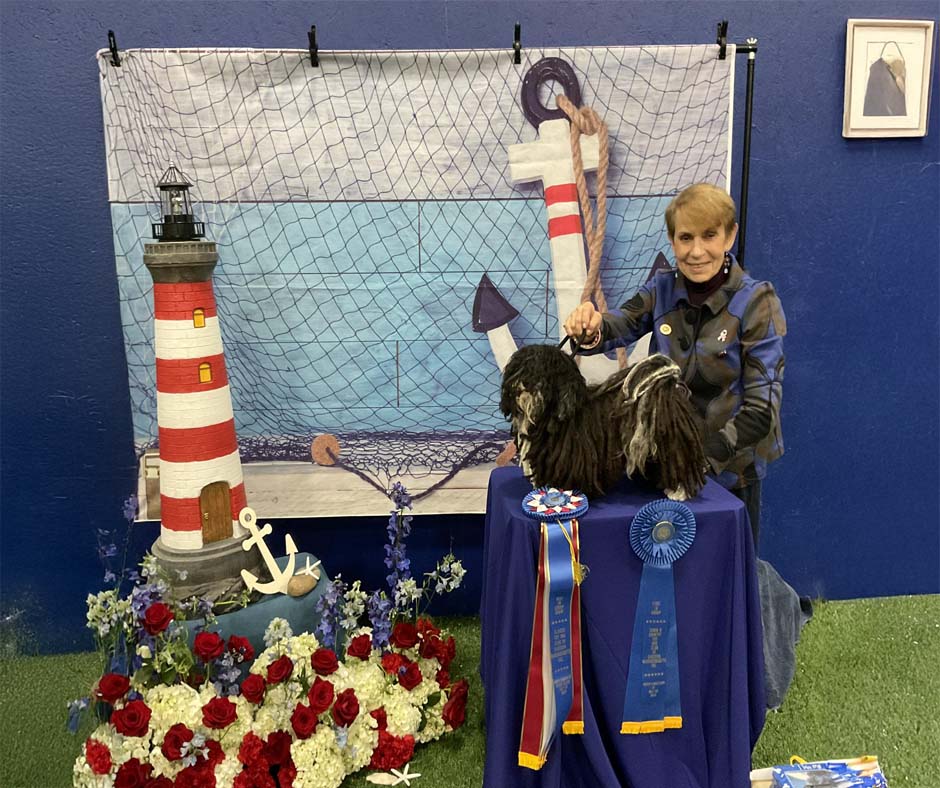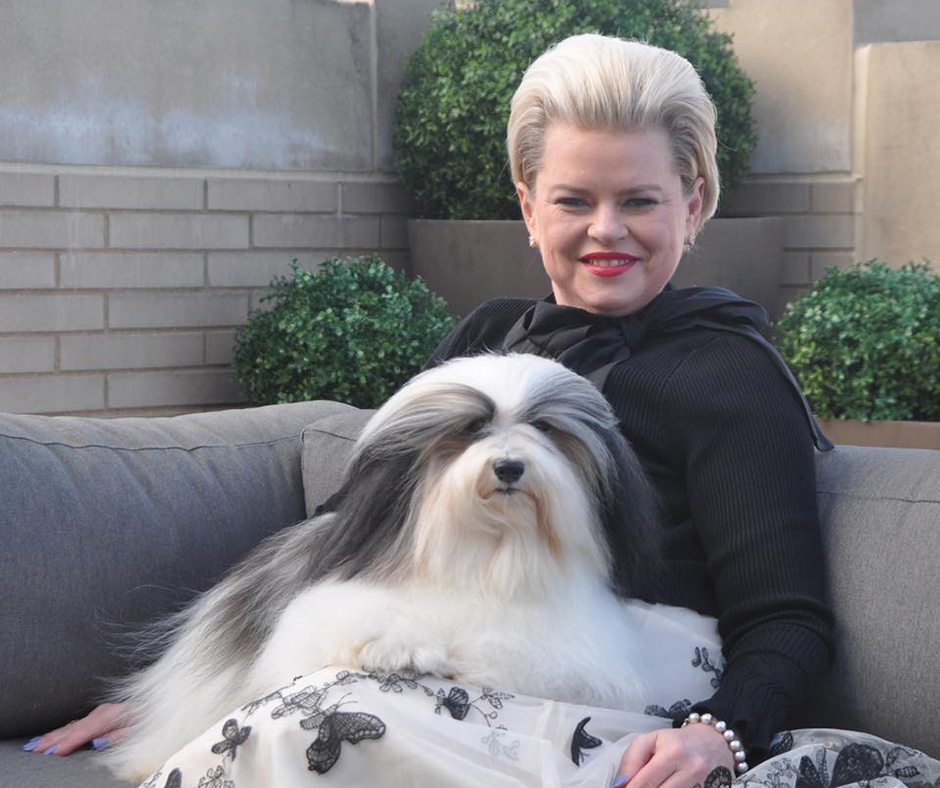706 – Queen of Cords: Alice Lawrence on 55 Years of Corded Breeds
Queen of Cords: Alice Lawrence on 55 Years of Corded Breeds

Alice Lawrence with BISS GRCHB Fuzzy Farm All Things Considered (aka Spaetzle, on the left) and YOLO (on the right) Moonshadow You Only Live Once At The Fuzzy Farm.
Host Laura Reeves is joined by Alice Lawrence, breeder-owner-handler of Komondorok, Puli and Havanese, to discuss her beloved corded breeds.
Lawrence, along with her husband Steve, first owned an Old English Sheepdog. “We were brushing our arms off,” she said.
“In 1972, we acquired our first Komondor and there’s no looking back. And no, we never had another Old English Sheepdog. We love the breed. But we would never go back to brushing a dog like an Old English Sheepdog when you can have a dog of equivalent size or somewhat larger and be able to cord it.
While cording a coat can seem daunting, Lawrence said, “Well, compared to brushing, it is (much easier), but you have to understand what a cord is, why a coat cords, and how to maintain the cord. It’s a different discipline. We think it’s much easier than brushing, and it’s a lifetime of being able to have your dog in a proper coat rather than brushing the dog, showing it and shaving it down because you can’t keep up with brushing it.”
A “curated mat”
“We think of cords as being a protection, a protection from predators. And the coat is very important to the environment and to the work that they do. Komondor are protectors of the flock. They do guard against such things as wolves. A fully-corded Komondor, not necessarily the length of the coat, but the density of the coat, will prevent the wolf from biting the dog.
“The other thing is that Komondor and Puli in their native Hungary deal with very, very difficult weather conditions, and the coat protects them both from the cold as well as from the heat. It’s an insulator. So it’s really a very natural coat for the dogs to have for their entire life.
“To cord any breed you really need a coat that is a double texture, an undercoat and an outer coat, and the undercoat is a softer coat, it’s more cottony. The outer coat is wavier and it takes the wave of the outer coat to wind its way around the softer undercoat to create the cord.
“That’s what’s creating this, call it a mat. It’s a mat and it’s an elongated mat. The thickness of the mat, sometimes it’s natural as to whether or not a dog has a thick cord or a thinner cord, but for the most part it’s how you divide these mats that occur that will determine the thickness of the cord.”
580 – Tara Martin Rowell on Drop Coats and Competitive Spirit
Tara Martin Rowell on Drop Coats and Competitive Spirit
Tara Martin Rowell, breeder, handler and second generation dog woman, joins host Laura Reeves with recommendations on maintaining drop coats, the genetics of her competitive spirit and pro tips for succeeding at the highest level in the sport.

Tara Martin Rowell in her formative years with Maltese.
“Basically, I was born into Maltese,” Tara said. “My mom (AKC judge Vicki Abbott) and dad had me right after my mom had kind of gotten involved in the breed. In my younger life, it was all about the Maltese and my mom was very successful. (She) had the top winning toy dog of all time, a Maltese that she actually handled. That’s how I got introduced into dog shows as a young child.
“Something that I always say when people ask me, I think it’s very important, especially today for our younger generation, to at least get some sort of a business degree. You want to handle dogs, you got to know how to do the business side of it too, because it’s not just the glamour and the walking in the ring and the winning. I mean, that’s very small portion of it.

Tara Martin Rowell with Hank, GCH CH Scylla Small Kraft Re-Lit. Bred by Tara and her mom, Vicki Abbot. Owned by Ron Scott and Debbie Scott.
“I started my life picking up a lot of poop. A lot of dogs that I never walked in the ring with doing a lot of holding of dogs, doing a lot of keeping my mouth shut. I mean, there’s a lot of work that goes into that process of success, you know?
Favorite Dog Book
“I think Dog Steps would be the one everybody has to read. I think that you should reread it as you get older, especially if you’re aspiring to judge, even if you’ve been judging. I still think structure and anatomy is so important in a breeding program. In a breed like my main breed Maltese, I think people get away from the structure and the anatomy because they think the hair is so important. Hair’s very important, but it’s one piece of the puzzle that makes the whole puzzle work, and you can’t have one without the other.
Listen to the full episode for Tara’s recommendations on grooming routines, favorite products and secrets for success.


